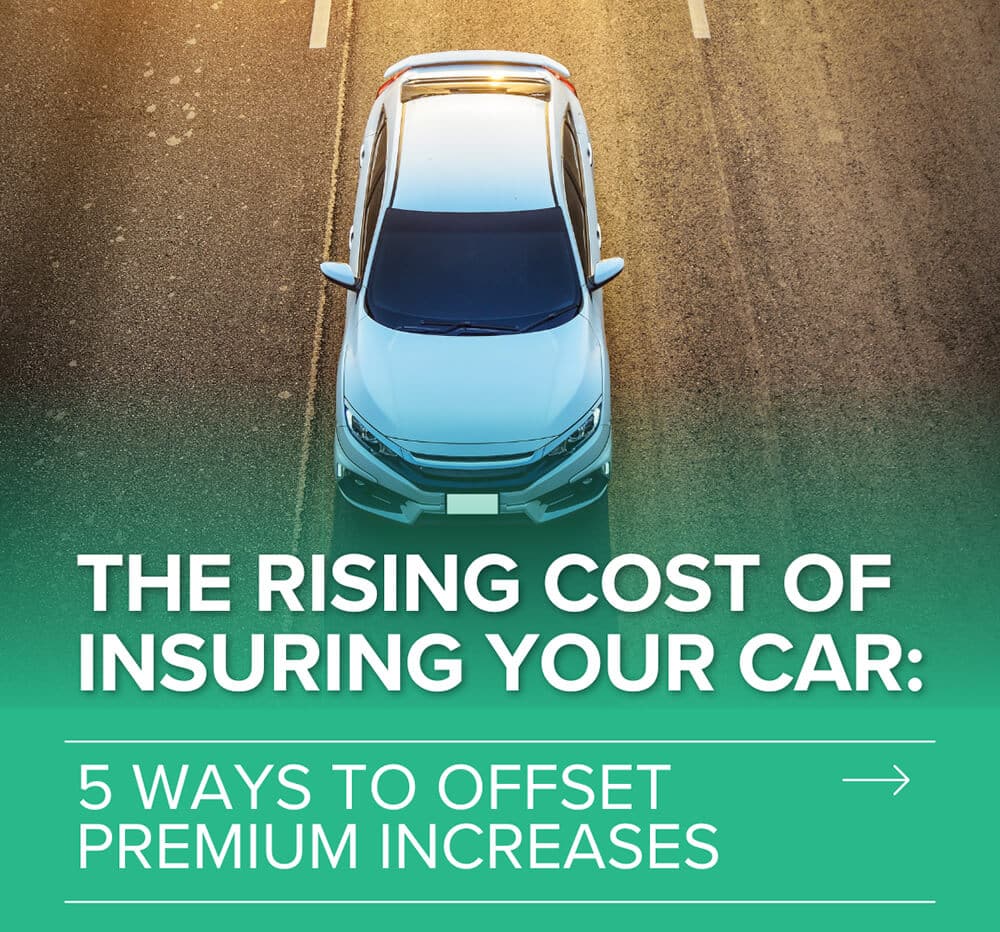Car insurance rates are climbing nationwide, squeezing the budgets of drivers across America. Premiums are spiking due to more claims being filed, pricier vehicle repairs, advanced safety technologies raising replacement part costs, distracted driving accidents, high-dollar injury settlement payouts, and outright fraud.
According to the 2023 US Auto Insurance Study by J.D. Power, 31% of car insurance companies in the US claimed a rate increase over the past year. The industry reported an average price jump of 15.5%, with some states like Florida seeing rates climb as high as 88% in the last 12 months.
The US Bureau of Labor Statistics Consumer Price Index (CPI) confirms auto insurance costs rose over 17% for American drivers. Progressive estimates its average cost for a basic liability-only policy now ranges from $81-$146 per month.
This article explores the key reasons behind the current rising rate environment in-depth, along with five tips to minimize the hit to your wallet when insuring your car.
Why Are Insurance Rates Going Up?
According to industry analysts, auto insurance premiums currently rise up to 20% nationwide when policies renew. These dramatic increases result primarily from the following factors.
More Frequent Claims
The number of accidents occurring on US roadways has increased substantially since 2020. Congested traffic, distracted driving, extreme weather events, and a general decline in safe driving practices all contribute to the climbing accident and claim volume.
Costlier Vehicle Repairs
New cars feature extensive safety gear, infotainment technology, sensors to enable self-driving capabilities and high-strength structural materials. While these innovations protect occupants better in a crash, they prove extremely expensive to repair afterward.
Insurers pay out much more in loss payments when policyholders file claims today compared to just 5-10 years ago. Again, carriers pass the rising costs along through significant rate hikes, which directly hit your wallet.
Advanced Safety Gear Means Higher Replacement Part Costs
Those same advanced safety technologies keeping occupants safer in new vehicles also raise repair costs dramatically following accidents. Sensors, cameras, radar emitters, control modules, lane keep assist machinery, automatic emergency braking mechanics, and adaptive cruise components easily run over $5,000 to replace after damage occurs.
Pandemic Driving Habits Persist with Dangerous Consequences
In 2021 alone, the National Highway Traffic Safety Administration documented a dramatic 21% spike in roadway fatality rates compared to pre-pandemic years. Excess speed accounts for about a third of those deaths. Extreme deadly crashes also cause insurers much higher liability payouts; costs ultimately passed to drivers.
Smartphone Distractions Lead to More Accidents
Handheld phone use while driving remains a widespread issue despite awareness of the dangers. About 35% of drivers admit to texting while operating vehicles routinely. This distraction contributes to a substantial number of accidents annually.
High-Dollar Injury Settlements
Settlement payouts by insurance companies related to accidents have increased substantially as well. With rising medical costs and skilled plaintiff attorneys fighting for bigger rewards, bodily injury liabilities now run insurers about $90,000 per injured claimant.
Key Takeaway: Premiums are rising due to increased claims, costlier repairs, pricier cars, distracted driving, and fraud.

Tip 1 – Compare Rates Thoroughly
The single most effective way to combat rising premiums remains shopping your coverage around at each renewal. Don’t automatically renew with your current insurer without checking the latest rates from competitors.
Get fresh comparative quotes from several auto insurance carriers, including national powerhouses. Check prices from regional and local insurers as well. With over 200 companies selling policies across America, you have options.
Key Takeaway: Compare identical quotes from at least three insurers at each renewal period to find potential savings.
Tip 2 – Raise Deductibles
Another great way to offset general inflation involves adjusting your deductibles. Comprehensive and collision coverage both require you to select a deductible or the amount you pay toward repairs before insurance benefits kick in.
Most drivers choose relatively low deductibles, from $250 to $500 when first buying policies. But if funds allow, you can substantially reduce premiums by accepting higher out-of-pocket risk.
For example, elevating your deductibles from $500 to $1,000 could lower comprehensive and collision premiums by a combined 30% or more. Jumping to a $2,500 deductible may cut those costs in half. Just be sure you have adequate savings to cover the higher amounts in the event you need to file a claim.
Key Takeaway: Raising deductibles can significantly reduce premiums, but be sure you have enough savings to cover the increased costs when filing a claim.
Tip 3 – Take Advantage of All Available Discounts
Almost every auto insurance company offers an array of discounts to help offset rising premiums. But shockingly, most drivers fail to capitalize on 5-10 potential savings opportunities. Leaving discounts unclaimed makes rate hikes hurt much more at renewal time.
Here are some of the most overlooked ways policyholders can slash bills by up to 30% from list pricing:
Multi-Policy Discount
If you currently buy home or renters coverage from a separate insurer than your vehicles, almost certainly bundling them together will score you big savings.
Multi-Car Discount
Adding all household vehicles to one policy also reduces costs 5-15% compared to maintaining separate accounts. And you only pay one deductible when multiple cars get damaged in the same covered event.
Good Driver Discount
Five years with no accidents or violations make you eligible for up to 30% off premiums in many states and companies. Maintaining a stellar record keeps rates lowest.
Defensive Driver Discount
Brush up on safety practices with an approved online or classroom course every few years.
Low Mileage Discount
Driving less annually reduces risk and earns you a lower rate in most cases. Customize policies if your mileage drops after retiring or the pandemic alters your commute.
Affinity Group Discounts
Many insurers offer special savings through employer, occupational, educational, or membership affiliations. Ask what groups you may belong to score discounted pricing.
Car Safety Feature Discounts
Factory additions like airbags, antilock brakes, automatic seatbelts, daytime running lights, alarm systems, and more earn you a break on premiums, too.
Key Takeaway: Take advantage of all possible discounts like low mileage, multi-policy, and defensive driving to maximize savings.
Tip 4 – Maintain Spotless Driving Records
Driving carefully and avoiding tickets, accidents, violations, and claims will also substantially shelter you from rate increases at renewal. Obey all traffic laws, constantly scan for hazards, leave plenty of following distance, signal properly, and avoid distractions.
Defensive drivers almost never cause accidents. Casual habits protect both your physical and your insurance premium balance from hikes. Just one incident can raise your costs for years while avoiding issues keeps your bill minimal through each renewal.
Key Takeaway: Drive safely and maintain a clean record, or take defensive driving classes if you get charged to avoid costly insurance hikes.
Tip 5 – Adjust Coverage as Needed
The final way to combat rising premiums involves regularly reviewing your specific auto insurance coverage details with an agent or company rep. As life circumstances change, you may no longer need certain coverages charging you extra currently.
For example, eliminate collision and comprehensive on older cars no longer worth over a few thousand dollars. Reduce liability limits once the kids leave the nest, and extensive umbrella policies become unnecessary. And ditch rental reimbursement coverage when you switch jobs and have access to a company fleet or pool car.
Key Takeaway: Regularly review your policy and adjust coverage when your circumstances change to avoid overpaying.

Final Thoughts
Industry analysts expect car insurance rates to keep climbing higher over at least the next 3-5 years. Some predict that accumulated premium inflation will reach 30-50% by 2027 before leveling out. So, the tips provided will remain crucial for offsetting unrelenting increases annually.
Shopping coverage diligently, raising deductibles, capitalizing on all available discounts, maintaining spotless driving records, and reviewing policies to control costs offer the best ways to shelter household budgets from swelling auto insurance bills.




